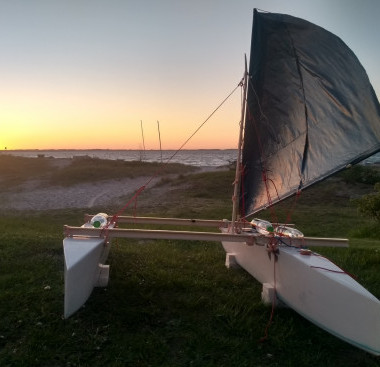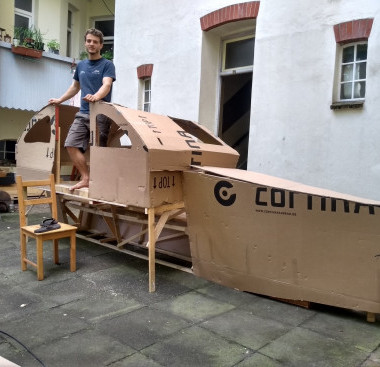The Proasis Project
Henrik Richter-Alten has submitted a new proa development project to Proafile called Proasis. His team has recently completed the launch and a successful test sail. Henrik explains:
“I’ve started the Proasis Project together with Christian Arriens, a good friend of mine. We are both involved in the Low Carbon Sea Transport Project at WAM*. My contribution was the WAM Catamaran design, he did the recently launched solar-electric component for low wind days. The idea behind the project is that we all share the same ocean - if the sea level is rising in the Marshall Islands (pretty obvious when you go there) it does as well everywhere else in the world. I’m an islander myself, Christian grew up in Hamburg, also close by the water. We never felt affected by climate change until we came to Majuro for the work at WAM - a true eye-opener! We want to open as many eyes as possible with Proasis to make people act now. That’s why we picked the most unusual boat in a very uncommon color. Everyone is looking at it and people come to talk. A Marshallese saying is ‘Wa kuk Wa jimor’. It means ‘canoes bring people together’. We want to do that in every possible way by sharing stories, connecting people to the ocean and encourage them to action.
“Proasis is my own design, strongly inspired by the Marshallese canoes I was honored to build and sail on. The leeward hull is 8.6 m (28.2’) long, the windward hull 6.25 m (20.3’), overall weight is 500 kg (1102 lb), the sail is only 15 sq m (161 sq. ft.). The concept is adapted to the rough conditions we face here in the north: Most of the time it is cold and rainy, so it is important to have a sheltered space for the crew while under way. Traditional canoes and modern interpretations like Jzerro or Madness can’t offer that because they are always open to windward and the crew sits in the rain and spray. So what we need here is something more like a drua configuration with a sheltered cabin on the windward hull. A visit to Rob Denney’s place gave some inspiration for the final setup.
“The waves on the Baltic sea are often very steep and short, V-hulls can suffer from terrible hobby-horsing in these conditions. To avoid that, the Proasis hulls are, unlike the traditional Marshallese hulls, long and boxy (lots of buoyancy in the ends) with only a little bit of rocker. That makes them very stable in any kind of chop. Aside of that, the rounded box section allows for a very hydrodynamic shape and a shallow draft of 20 cm (7.9”).
“To counter the sail we use a centered, bi-directional leeboard with ogival shape. It’s mounted on the inside of the hull. The rudders (old F-18 daggerboards in cassettes) are mounted to hinges on the beams. Only the rear rudder is down while sailing, the front one is folded under the trampoline. The rudders are connected by bar in a way that if one swings down the other one comes up and locks in place. This mechanism is controlled by one line and operated in seconds.
“To shunt, the sail is simply re-stepped on the other end of the leeward hull (100% Marshallese style). It’s far easier than it sounds, the design of the shrouds automatically supports the motion (we will post a detailed video on that topic soon).
“The windward hull features a cabin with two single bunks, space to sit, a galley and a navigation station. It is functional and comfortable to live in for a couple of weeks. We plan to add a tent for the trampoline for more living space.
“Proasis is not meant to be a race boat, it is designed for comfortable cruising. So far we’ve reached more than 10 kn, but the average travel speed is more likely something between 6-8 kn. A larger sail would make her faster but also less comfortable to sail. Right now she is so well balanced that we can lash the tiller and sail a straight line for hours.
“Proasis is entirely made from plywood and timber, a good share of it recycled (i.e. old furniture), reinforced with glass fiber and epoxy. The spars are made from old windsurfer masts, the sail is a polytarp sheet for 30€. In total we’ve spent 4000€ on her, that includes the rent for the workshop, electricity, some tools, firewood and transportation.
“Our next goals include further testing, especially in winds stronger than 25 kn. In September we plan to be part of Kiel Week, one of the world’s largest sailing festivals. We will post regular updates on our website and upload videos to to the youtube channel.”
Follow the project on YouTube and at their website www.proas.is
* WAM: Waan Aelõñ in Majel “Canoes of the Marshall Islands”.






Excellent idea, linking the rudders so when one goes down, the other goes up. I’m stealing that one. Thanks.